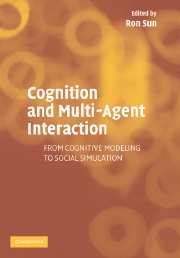Book contents
- Frontmatter
- Contents
- List of Contributors
- Preface
- PART 1 INTRODUCTION
- PART 2 OVERVIEWS OF COGNITIVE ARCHITECTURES
- PART 3 MODELING AND SIMULATING COGNITIVE AND SOCIAL PROCESSES
- 5 Cognitive Architectures, Game Playing, And Human Evolution
- 6 Simulating A Simple Case Of Organizational Decision Making
- 7 Cognitive Modeling of Social Behaviors
- 8 Cognitive Agents Interacting in Real and Virtual Worlds
- 9 Modeling Social Emotions and Social Attributions
- 10 Communicating and Collaborating with Robotic Agents
- 11 Behavior-Based Methods for Modeling and Structuring Control of Social Robots
- 12 Evolution of a Teamwork Model
- 13 Sociality in Embodied Neural Agents
- 14 Cognitive Architecture and Contents for Social Structures and Interactions
- PART 4 A SYMPOSIUM
- Index
9 - Modeling Social Emotions and Social Attributions
Published online by Cambridge University Press: 15 December 2009
- Frontmatter
- Contents
- List of Contributors
- Preface
- PART 1 INTRODUCTION
- PART 2 OVERVIEWS OF COGNITIVE ARCHITECTURES
- PART 3 MODELING AND SIMULATING COGNITIVE AND SOCIAL PROCESSES
- 5 Cognitive Architectures, Game Playing, And Human Evolution
- 6 Simulating A Simple Case Of Organizational Decision Making
- 7 Cognitive Modeling of Social Behaviors
- 8 Cognitive Agents Interacting in Real and Virtual Worlds
- 9 Modeling Social Emotions and Social Attributions
- 10 Communicating and Collaborating with Robotic Agents
- 11 Behavior-Based Methods for Modeling and Structuring Control of Social Robots
- 12 Evolution of a Teamwork Model
- 13 Sociality in Embodied Neural Agents
- 14 Cognitive Architecture and Contents for Social Structures and Interactions
- PART 4 A SYMPOSIUM
- Index
Summary
INTRODUCTION
Emotions play a crucial role in mediating human social relationships (Davidson, Scherer,& Goldsmith, 2003). Whether articulated through body movements, voice, deed, or through the ways we justify our actions, human relationships are laden with emotion. Emotion can act as a signal, communicating information about the sender's mental state, indicating his or her future actions, and indirectly inducing emotions in the mind of observers. Emotion can also act as a mental process, altering how people see the world, how they form decisions, and how they respond to the environment. In our work we seek to develop testable computational models that emphasize the relationship between emotion and cognition (Gratch & Marsella, 2001; Marsella & Gratch, 2003). In this chapter, we focus on emotions that have a social component: the rage arising from a perceived offence, the guilt we feel after harming another. Such emotions arise from social explanations involving judgments not only of causality but intention and free will (Shaver, 1985). These explanations underlie how we act on and make sense of the social world. In short, they lie at the heart of social intelligence. With the advance of multi-agent systems, user interfaces, and human-like agents, it is increasingly important to reason about this uniquely human-centric form of social inference. Here we relate recent progress in modeling such socio-emotional judgments.
Modeling emotions is a relatively recent focus in artificial intelligence and cognitive modeling and deserves some motivation. Although such models can ideally inform our understanding of human behavior, we see the development of computational models of emotion as a core research focus that will facilitate advances in the large array of computational systems that model, interpret or influence human behavior.
- Type
- Chapter
- Information
- Cognition and Multi-Agent InteractionFrom Cognitive Modeling to Social Simulation, pp. 219 - 251Publisher: Cambridge University PressPrint publication year: 2005
- 5
- Cited by



